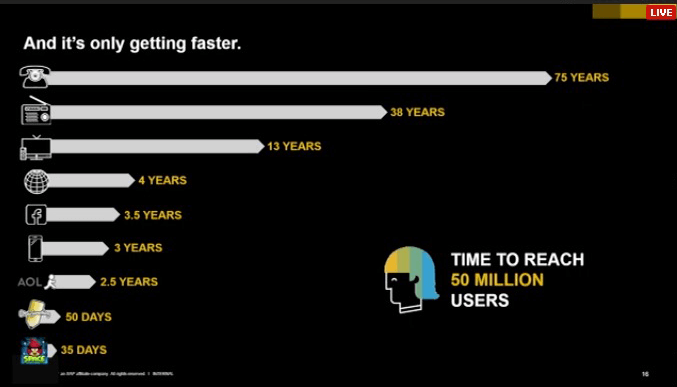Before assembly lines, prior to the turn of the 20th century, no one talked about “customer engagement.” Times have changed. Technology has come far and fast since then. Customers are driving the economy with an insatiable desire to identify the next “new” thing.
In his keynote presentation at the SAP Hybris Digital Summit, CMO Jamie Anderson explained how economies have changed, and how those changes have impacted adaptation rates of new technologies.
With the industrial revolution and the introduction of the assembly line, Ford was able to deliver the Model T on a scale that was previously unaffordable. This changed production and the availability of goods. Then came a consumer-driven economy in the 1950’s. Products were now sitting on shelves, waiting for purchase. This led to the introduction of marketing, sparking desire for consumer purchases.
Digital adaptation rates soar
Now, we are in the midst of the digital economy. The internet and all the technology arising from it – including artificial intelligence, data streaming, and all those associated with portable devices – have changed how we live, work, shop, and communicate.
Formerly measured in years, the adoption of new technology can now be measured in days. Radios, a critical product in the early 20th century, took 38 years to reach 50 million users, and was the major delivery agent for news and entertainment. It offered soap operas when people needed to escape during the Great Depression, and news updates on World War II. And it took 38 years to reach 50 million users. Today, a new app can reach that many people in a month.
What are customers looking for? Whatever will make their lives easier and more enjoyable. Wearables that help them to monitor and improve their fitness; cars with the ability to monitor traffic conditions and collision aversion technology; washing machines that can order more laundry detergent when you’re running low.
Machine learning and artificial intelligence (AI) are taking over more and more mundane, monotonous tasks. According to Gartner, six billion “things” will be supported by AI by 2018. Cars are expected to be driverless, drones will deliver packages, software will offer financial advice.
If the technology delivers convenience and ease to customers, it greatly impacts adoption rates. Therefore, the customer must be at the heart of a business’s strategy in managing technology adoption.
“Always be on your toes. Never be caught flat-footed,” Anderson says, reflecting on the advice provided by his childhood coach. He grew up in Scotland, playing football on muddy grounds. If you weren’t running on your toes, then you couldn’t change directions quickly. Being flat footed meant getting – literally – stuck in the mud.
“Always be on your toes. Never be caught flat-footed”
Businesses must be flexible and agile. The marketplace is ever dynamic now, and business models and strategies should reflect a readiness to change quickly. To do this, think “customer first.” Be accessible across all channels of communication, especially social media. Identify consumer pain points and understand why they choose one technology over another.
The data and technology is available to support and transform businesses, so there’s no need to feel daunted. Invest in systems that will improve your customer experience and understand what drives them. Feel empowered to embrace the change that can help business better meet customer needs and lifestyle.
It’s not too late to catch up on the exclusive insights, panels and thought-leadership shared at the SAP Hybris Digital Summit. You can watch them here!


